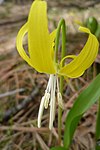Erythronium grandiflorum
| Erythronium grandiflorum | |
|---|---|

| |
| Erythronium grandiflorum Mount Rainier National Park | |
| Scientific classification | |
| Kingdom: | Plantae |
| Clade: | Tracheophytes |
| Clade: | Angiosperms |
| Clade: | Monocots |
| Order: | Liliales |
| Family: | Liliaceae |
| Subfamily: | Lilioideae |
| Tribe: | Lilieae |
| Genus: | Erythronium |
| Species: | E. grandiflorum
|
| Binomial name | |
| Erythronium grandiflorum | |
| Synonyms[1] | |
|
Synonymy
| |
Erythronium grandiflorum is a North American species of plants in the lily family.[1] It is known by several common names, including yellow avalanche lily, glacier lily, and dogtooth fawn lily.[2][3] The Ktunaxa name for glacier lily is maxa.[4]
Description
[edit]Erythronium grandiflorum grows from a deep bulb (or corm) which is 3 to 5 centimeters wide. Its two green leaves are wavy-edged and up to 20 centimeters long. The stalk may reach 30 centimeters tall and bearss one to three showy flowers. Each flower has bright lemon yellow petals, white stamens with large white to yellow to red anthers, and a white style.[5]
The Flora of North America recognizes two subspecies, the yellow-flowered subsp. grandiflorum and the white- to cream-flowered subsp. candidum.[6] More recent publications consider subsp. candidum to be a distinct species, called Erythronium idahoense.[1]
Distribution and habitat
[edit]It is native to western North America from British Columbia and Alberta south to New Mexico and California, though it has not been reported from Arizona or Nevada.[7] It can be found in subalpine mountain meadows, slopes, and clearings.[1][8]
Ecology
[edit]The flower is pollinated by bumblebees and other bees. The bulbs are an important and preferred food of the grizzly bear. Mule deer readily eat the foliage.[9][10][11]
After hummingbirds migrate 1,500 miles each year from Mexico to the Rocky Mountains of Colorado they collect energy from the nectar of the lilies, however, rising temperatures from global warming cause the flowers to bloom, and also to wither, earlier each year. As of 2023, the danger is foreseen that in 20 years the birds may arrive from their long migration to find their usually reliable nourishment unavailable because of premature withering.[12]
Uses
[edit]The bulbs can be eaten cooked or raw to avoid starvation[13] (though they can cause nausea this way).[14] The leaves and flowers are also edible raw or cooked.[15]
Gallery
[edit]-
Bud and flower
-
Blooms in Missoula, Montana
-
Young fruit
References
[edit]- ^ a b c d Kew World Checklist of Selected Plant Families
- ^ Jepson Manual Treatment
- ^ United States Department of Agriculture Plants Profile
- ^ "FirstVoices- Ktunaxa. Plants: food plants: words". Archived from the original on 2015-09-24. Retrieved 2012-07-07.
- ^ "Yellow Avalanche Lily, Erythronium grandiflorum". calscape.org.
- ^ Flora of North America 26 Page 156, Glacier-lily, Erythronium grandiflorum Pursh, Fl. Amer. Sept. 1: 231. 1814
- ^ Biota of North America Program 2014 county distribution map
- ^ Clennett, C. (2014). The genus Erythronium: 1-158. Kew Publishing, Kew.
- ^ Pursh, Frederick Traugott. 1814. Flora Americae Septentrionalis 1: 231
- ^ Hitchcock, C. H., A.J. Cronquist, F. M. Ownbey & J. W. Thompson. 1969. Vascular Cryptogams, Gymnosperms, and Monocotyledons. 1: 1–914. In C. L. Hitchcock Vascular Plants of the Pacific Northwest. University of Washington Press, Seattle.
- ^ Applegate, Elmer Ivan. 1933.
- ^ "Ice". Evolution Earth. Season 1. Episode 4. 22 October 2023. PBS.
- ^ Reiner, Ralph E. (1969). Introducing the Flowering Beauty of Glacier National Park and the Majestic High Rockies. Glacier Park, Inc. p. 36.
- ^ Benoliel, Doug (2011). Northwest Foraging: The Classic Guide to Edible Plants of the Pacific Northwest (Rev. and updated ed.). Seattle, WA: Skipstone. p. 91. ISBN 978-1-59485-366-1. OCLC 668195076.
- ^ Nyerges, Christopher (2017). Foraging Washington: Finding, Identifying, and Preparing Edible Wild Foods. Guilford, CT: Falcon Guides. ISBN 978-1-4930-2534-3. OCLC 965922681.






